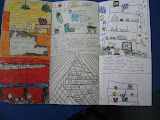 We are doing paper plate weaving as part of our visual art.
We are doing paper plate weaving as part of our visual art.Here is what we did...
1. Decided on the shape e.g. fan, concentric, circles, stripes etc
2. Cut notches in the plates in appropriate places and wound the warp threads with wool.
3. Chose our fabric strips for the weft, and wove them in and out to get the right shape. Tucked or glued the odd ends into the back of the work, and trimmed the edges.
4. Used beads, sequins,feathers, foil as decoration.

Looms can be made from many things. They may be commercially bought, circular or square notched looms, or may be home-made from a shoebox lid or plastic ice-cream lid. They may be made from notched paper plates or curved pieces of card. You could weave on a forked twig, a bicycle wheel, a wire coat hanger, a refrigerator shelf, a bent piece of copper pipe, a clothes horse or the upturned legs of a chair. The only criterion is that the warp threats are held taut.















































